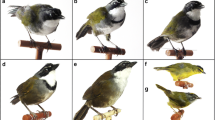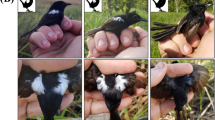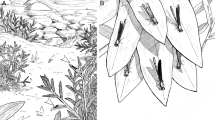Abstract
Male ornamentation is assumed to have evolved primarily from selection by female mate choice. Yet this is only one possible reason for ornament evolution. Ornaments might also be useful in aggressive competition by improving opponent assessment between males, or they might function to enhance signal detection by making males more conspicuous in the environment. We tested both these ideas in territorial Anolis lizards in which female choice is either absent or secondary to males competing for territories that overlap female home ranges. Male tail crests only evolved in species in which territory neighbors were distant, consistent with the signal detection hypothesis. Once the tail crest had evolved, however, it seems to have become a signal in itself, with variation in the frequency and size of tail crests within species correlating with variables predicted by the aggressive competition hypothesis. Our study presents an apparent example of a male ornament in which the selection pressure leading to variation among species in ornament expression is different from the selection pressure acting on variation within species. The Anolis tail crest is therefore likely to be an exaptation. We caution that conclusions made on the evolution of male ornaments are dependent on the phylogenetic perspective adopted by a study. Studies restricted to single species are useful for identifying selection pressures in contemporary settings (i.e., the current utility of traits), but may lead to erroneous conclusions on the factors that initially lead to the origin of traits.




Similar content being viewed by others
References
Andersson M (1994) Sexual selection. Princeton University Press, Princeton, New Jersey
Basolo AL (1990) Female preference predates the evolution of the sword in swordtail fish. Science 250:808–810
Basolo AL, Alcaraz G (2003) The turn of the sword: length increases male swimming costs in swordtails. Proc R Soc Lond B 270:1631–1636
Benjamini Y, Hochberg Y (1995) Controlling the false discovery rate: a practical and powerful approach to multiple testing. J R Stat Soc B 57:289–300
Dakin R, Montgomerie R (2009) Peacocks orient their courtship displays towards the sun. Behav Ecol Sociobiol 63:825–834
Darwin C (1874) The descent of man, 2nd edn. Prometheus Books, New York
Endler JA (1987) Predation, light intensity and courtship behaviour in Poecilia reticulata (Pisces: Poeciliidae). Anim Behav 35:1376–1382
Fleishman LJ (1992) The influence of the sensory system and the environment on motion patterns in the visual displays of anoline lizards and other vertebrates. Am Nat 139:S36–S61
Garcia CM, Ramirez E (2005) Evidence that sensory traps can evolve into honest signals. Nature 434:501–505
Gould SJ, Vrba ES (1982) Exaptation—a missing term in the science of form. Paleobiology 8:4–15
Grether GF (2000) Caroteniod limitation and mate preference evolution: a test of the indicator hypothesis in guppies (Poeclia reticulata). Evolution 54:1712–1724
Hebets EA, Uetz GW (2000) Leg ornamentation and the efficacy of courtship display in four species of wolf spider (Araneae: Lycosidae). Behav Ecol Sociobiol 47:280–286
Jackman TR, Irschick DJ, de Queiroz K, Losos JB, Larson A (2002) Molecular phylogenetic perspective on evolution of lizards of the Anolis grahami series. J Exp Zool 294:1–16
Leal M, Fleishman LJ (2002) Evidence for habitat partitioning based on adaptation to environmental light in a pair of sympatric lizard species. Proc R Soc Lond B 269:351–359
Losos JB (2009) Lizards in an evolutionary tree: ecology and adaptive radiation of anoles. University of California Press, Berkeley, CA
Maddison WP, Maddison DR (2009) Mesquite: a modular system for evolutionary analysis. Version 2.71. Available free from: http://mesquiteproject.org.
Martins EP (2004) COMPARE 4.6b: statistical analysis of comparative data. Available free from http://compare.bio.indiana.edu/.
Nicholson KE, Glor RE, Kolbe JJ, Larson A, Hedges SB, Losos JB (2005) Mainland colonization by island lizards. J Biogeo 32:929–938
Ord TJ (2008) Dawn and dusk ‘chorus’ in visually communicating Jamaican anole lizards. Am Nat 172:585–592
Ord TJ, Charles GK, Hoffer RK (2011) The evolution of alternative adaptive strategies for effective communication in noisy environments. Am Nat 177:54–64
Ord TJ, Peters RA, Clucas B, Stamps JA (2007) Lizards speed up visual displays in noisy motion habitats. Proc R Soc Lond B 274:1057–1062
Ord TJ, Stamps JA (2008) Alert signals enhance animal communication in ‘noisy’ environments. Proc Natl Acad Sci, USA 105:18830–18835
Ord TJ, Stamps JA (2009) Species identity cues in animal communication. Am Nat 174:585–593
Ord TJ, Stamps JA, Losos JB (2010) Adaptation and plasticity of animal communication in fluctuating environments. Evolution 64:3134–3148
Ord TJ, Stuart-Fox D (2006) Ornament evolution in dragon lizards: multiple gains and widespread losses reveal a complex history of evolutionary change. J Evol Biol 19:797–808
Park KJ, Buchanan KL, Evans MR (2001) Sexy streamer? The role of natural and sexual selection in the evolution of Hirundine tail streamers. Evolution 55:445–446
Paterson A (1999) Effects of prey availability on perch height of female bark anoles, Anolis distichus. Herpetologica 55:242–247
Petrie M, Halliday T, Sanders C (1991) Peahens prefer peacocks with elaborate trains. Anim Behav 41:323–331
Prum RO (1994) Phylogenetic analysis of the evolution of alternative social behaviour in the Manakins (Aves: Pipridae). Evolution 48:1657–1675
Pryke SR, Andersson S (2002) A generalized female bias for long tails in a short-tailed widowbird. Proc R Soc Lond B 269:2141–2146
Revell LJ, Harmon LJ, Collar DC (2008) Phylogenetic signal, evolutionary process, and rate. Syst Biol 57:591–601
Rodd FH, Hughes KA, Grether GF, Baril CT (2002) A possible non-sexual origin of mate preference: are male guppies mimicking fruit? Proc R Soc Lond B 269:475–481
Rodríguez Schettino L (1999) The iguanid lizards of Cuba. University Press of Florida, Gainesville
Rohwer S (1982) The evolution of reliable and unreliable badges of fighting ability. Am Zool 22:531–546
Rosenthal GG, Evans CS (1998) Female preference for swords in Xiphophorus helleri reflects a bias for large apparent size. Proc Natl Acad Sci USA 95:4431–4436
Rosenthal GG, Evans CS, Miller WL (1996) Female preference for dynamic traits in the green swordtail, Xiphophorus helleri. Anim Behav 51:811–820
Stamps JA (1973) Displays and social organization in female Anolis aeneus. Copeia 1973:264–272
Stamps JA (1983) Sexual selection, sexual dimorphism, and territoriality. In: Huey RB, Pianka ER, Schoener T (eds) Lizard ecology: studies of a model organism. Harvard University Press, Cambridge, Massachusetts, pp 169–204
Sztatecsny M, Strondl C, Baierl A, Ries C, Hödl W (2010) Chin up: are the bright throats of male common frogs a condition-independent visual cue? Anim Behav 79:779–786
Tokarz RR (1995) Mate choice in lizards: a review. Herpetol Monogr 9:17–40
Tokarz RR (1998) Mating pattern in the lizard Anolis sagrei: implications for mate choice and sperm competition. Herpetologica 54:388–394
Vanhooydonck B, Herrel AY, Van Damme R, Irschick DJ (2005) Does dewlap size predict male bite performance in Jamaican Anolis lizards? Funct Ecol 19:38–42
Acknowledgments
We thank José Rosado for access to the herpetology collections of the MCZ, Luke Mahler for useful references and help on identifying Cuban species with tail crests, and Jonathan Losos and two anonymous reviewers for insightful comments on a previous version of this manuscript. This work was supported by a US National Science Foundation grant (IOB-0517041/0516998) to TJO, Judy A. Stamps, and Jonathan B. Losos. All data from this publication have been archived in the Dryad Digital Repository (doi:10.5061/dryad.fg0kq00m). All research described in this article complied with the current laws of the USA and the territory of Puerto Rico under research permits to TJO from the Caribbean National Forest and Departamento de Recursos Naturales y Ambientales de Puerto Rico, and the Animal Use and Care Protocols 05-11652/15243 that were approved on March 24, 2005 and most recently reviewed on March 20, 2009 by the Institutional Animal Care and Use Committee of the University of California, Davis. The authors declare no conflict of interest.
Author information
Authors and Affiliations
Corresponding author
Additional information
Communicated by S. Downes
Rights and permissions
About this article
Cite this article
Charles, G.K., Ord, T.J. Factors leading to the evolution and maintenance of a male ornament in territorial species. Behav Ecol Sociobiol 66, 231–239 (2012). https://doi.org/10.1007/s00265-011-1271-6
Received:
Revised:
Accepted:
Published:
Issue Date:
DOI: https://doi.org/10.1007/s00265-011-1271-6




